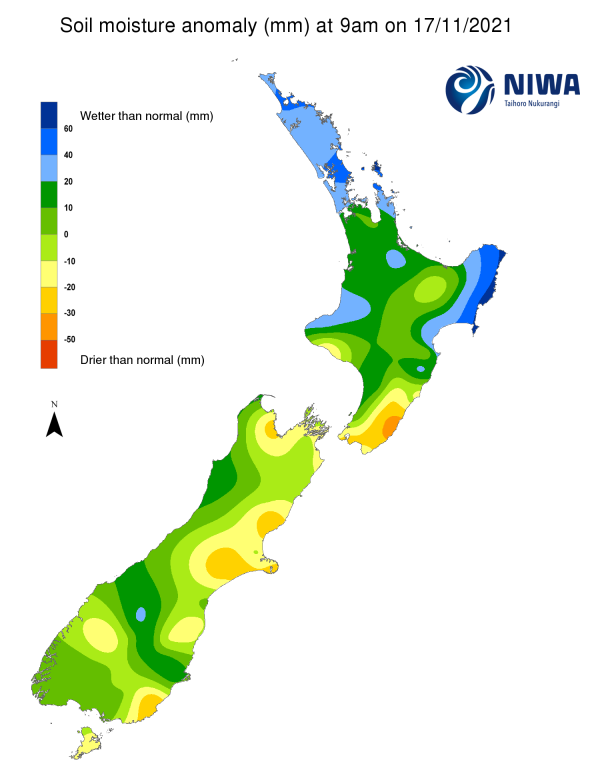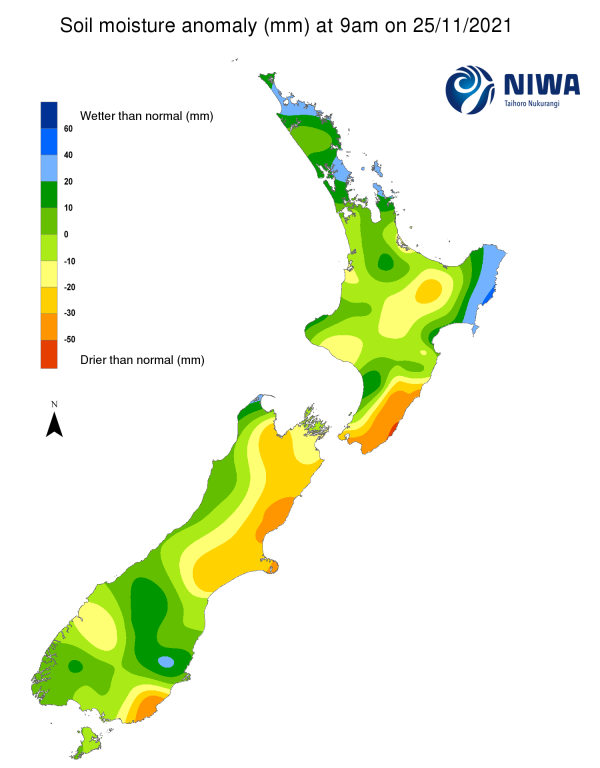A weekly update describing soil moisture patterns across the country to show where dry to extremely dry conditions are occurring or imminent. Regions experiencing significant soil moisture deficits are deemed “hotspots”. Persistent hotspot regions have the potential to develop into drought.
Facts: Soil Moisture
In the North Island, light rainfall amounts were observed in most areas during the past week. A large majority of the island received less than 15 mm, with pockets of rainfall as high as 25 mm in Northland as well as northern and central Waikato. In addition, parts of Kapiti Coast and Horowhenua received more than 30 mm during the past week. This generally light rainfall resulted in moderate soil moisture decreases across the entire North Island. The driest soils across the North Island, when compared to normal for this time of the year, are found in coastal Wairarapa, while the wettest soils for this time of the year are found in coastal Gisborne.
During the past week, a new hotspot formed across much of Wairarapa. The New Zealand Drought Index (NZDI) map below shows that dry conditions are now located in coastal Wairarapa as of 23 November.
In the South Island, ongoing heavy rainfall in Fiordland and the lower West Coast has resulted in widespread amounts of 75-100 mm during the past week, with pockets of higher amounts. Amounts of 30-60 mm were observed farther north along the West Coast, as well as in Tasman and portions of interior Otago. Generally 20-30 mm occurred in the rest of Otago and Southland. However, generally meagre amounts of 10 mm or less were found in eastern Marlborough and much of Canterbury. This resulted in moderate soil moisture decreases across Nelson, much of Marlborough, and northern and central Canterbury. Elsewhere, generally little change was observed, although slight soil moisture increases occurred in Otago. The driest soils in the South Island, when compared to normal for this time of the year, are located in northern Canterbury, Banks Peninsula, and coastal Southland, while the wettest soils for this time of the year are found in parts of interior Otago and near Farewell Spit.
Hotspots are currently in place in eastern Marlborough, much of northern and central Canterbury, and portions of Banks Peninsula. The New Zealand Drought Index (NZDI) map below shows that dry conditions are now located in coastal Ashburton District as of 23 November.
Outlook and Soil Moisture
In the North Island, high pressure will continue to bring dry weather to most locations through Monday (29 November). However, isolated afternoon showers will continue to affect a few areas each day, bringing locally light rainfall amounts. The chance for rain will increase during the middle of next week as weak low pressure moves over the North Island during the Tuesday-Thursday time frame. Weekly rainfall totals may only reach 10-20 mm in the upper North Island, while other areas may receive 20-40 mm.
Due to the expected rainfall in the next week, soil moisture levels are likely to decrease at least slightly across the upper North Island, while other areas may see little change. Depending on the exact distribution of the upcoming week’s rainfall, the current hotspot in Wairarapa may strengthen slightly.
In the South Island, heavy rain currently located in Fiordland and the lower West Coast will slowly move north through Sunday (28 November), potentially causing localised flooding. Lighter rainfall will also occur east of the Alps across Southland, Otago, and Canterbury during this time. During early-to-mid next week, the same low pressure affecting the North Island will bring light to moderate rainfall to much of the South Island. Weekly rainfall totals could approach or exceed 200 mm across much of the West Coast, with lighter amounts in Tasman. Elsewhere, moderate rainfall totals are possible, with widespread amounts of 25-40 mm, and pockets up to 50 mm.
Due to the expected rainfall, substantial soil moisture increases will be likely across the western South Island. Elsewhere, most locations will likely see at least small soil moisture increases as well. The existing hotspots in Marlborough and Canterbury may weaken at least slightly during the next week due to the moderate rainfall expected in these areas, although they may not dissipate completely.
Background:
Hotspot Watch: a weekly advisory service for New Zealand media. It provides soil moisture and precipitation measurements around the country to help assess whether extremely dry conditions are imminent.
Soil moisture deficit: the amount of water needed to bring the soil moisture content back to field capacity, which is the maximum amount of water the soil can hold.
Soil moisture anomaly: the difference between the historical normal soil moisture deficit (or surplus) for a given time of year and actual soil moisture deficits.
Definitions: “Extremely” and “severely” dry soils are based on a combination of the current soil moisture status and the difference from normal soil moisture (see soil moisture maps at https://www.niwa.co.nz/climate/nz-drought-monitor/droughtindicatormaps)
Hotspot: A hotspot is declared if soils are "severely drier than normal" which occurs when Soil Moisture Deficit (SMD) is less than -110 mm AND the Soil Moisture Anomaly is less than -20 mm.
Pictured above: Soil Moisture Anomaly Maps, relative to this time of year. The maps show soil moisture anomaly for the past two weeks.
New Zealand Drought Index (NZDI)
As of 23 November, the New Zealand Drought Index (NZDI) map below shows that dry conditions are now located in coastal Wairarapa and Ashburton District. Please note: some hotspots in the text above may not correspond with the NZDI map. This difference exists because the NZDI uses additional dryness indices, including one which integrates the rainfall deficit over the past 60 days. Changes are therefore slower to appear in the NZDI compared to soil moisture anomaly maps that are instantaneously updated.




